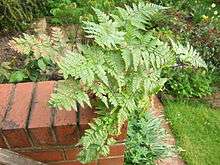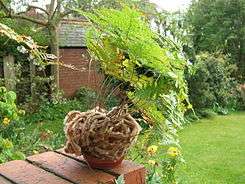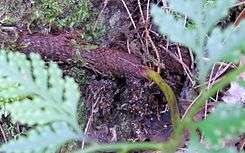Davallia
Davallia (deersfoot fern, hare's foot fern, shinobu fern, rabbit foot fern, ball fern) is a genus of about 40 species of fern. In the Pteridophyte Phylogeny Group classification of 2016 (PPG I), it is the only genus in the family Davalliaceae, which is placed in the suborder Polypodiineae, order Polypodiales.[1] Alternatively, the family may be placed in a very broadly defined family Polypodiaceae sensu lato as the subfamily Davallioideae.[2]
| Davallia | |
|---|---|
 | |
| Davallia canariensis in cultivation | |
| Scientific classification | |
| Kingdom: | Plantae |
| Clade: | Tracheophytes |
| Class: | Polypodiopsida |
| Order: | Polypodiales |
| Suborder: | Polypodiineae |
| Family: | Davalliaceae M.R.Schomb. |
| Genus: | Davallia (L.) Sm. |
| Species | |
|
See text | |
| Synonyms[1] | |
| |

The family is sister to the largest family of ferns, Polypodiaceae,[1] and shares some morphological characters with it.[3] Species are epiphytic ferns, with fronds arising from long aerial rhizomes which grow on and over thick bark on trees or on rock crevices.
Description
Usually epiphytic or epipetric. Rhizomes dictyostelic, dorsiventral, densely scaly. Stipes articulate at base. Phyllopodia short. veins free. Sporangium stalk 3-rowed. Annulus vertical. Spores monolete.
Taxonomy
Gymnogrammitis and Leucostegia were once included in Davalliaceae, but these are now known to belong elsewhere. Gymnogrammitis is in a clade with Selliguea and others in the family Polypodiaceae.[4] Leucostegia is in the family Hypodematiaceae,[5] which consists of Hypodematium and Leucostegia,[6] and possibly Didymochlaena as well.[7]
In 2008, a molecular phylogenetic study of Davalliaceae showed that none of the polyspecific genera recognized at that time were monophyletic.[8] In that same year, a revision of the family divided it into five genera.[5] One of these, Araiostegiella, was newly described. The genus Davallia was divided into two sections, named Davallia and Trogostolon. Based on molecular phylogenetic studies, the Pteridophyte Phylogeny Group classification of 2016 (PPG I) accepts only one genus in the family, Davallia, sinking the other genera into synonymy.[1] The study on which the PPG I circumscription is based divides the genus into seven sections.[9]
Phylogeny
The following cladogram for the suborder Polypodiineae (eupolypods I), based on the consensus cladogram in the Pteridophyte Phylogeny Group classification of 2016 (PPG I),[1] shows a likely phylogenetic relationship between Davalliaceae and the other families of the clade.
| Polypodiineae (eupolypods I) |
| ||||||||||||||||||||||||||||||||||||||||||||||||
Selected species
Many of the species of Davallia are closely related and hard to distinguish from each other. In 1990, a treatment of Davalliaceae estimated the number of species at 110.[3] A 2008 paper listed all of the species, recognizing only 63.[5] A new species, Davallia napoensis was described in 2011.[10] The Pteridophyte Phylogeny Group classification of 2016 (PPG I) suggests there are about 65 species.[1]
- Davallia bullata - Japan, China, and tropical Asia.
- Davallia canariensis - Canary Islands to Spain and north Africa.
- Davallia denticulata - Africa, India, China, Malesia, Indonesia, Polynesia, Australia
- Davallia divaricata (syn.: Davallia polyantha) - Tropical Asia.
- Davallia embolostegia
- Davallia fejeensis Hook (syn.: Davallia fijiensis) - Fiji Islands and Australia.
- Davallia mariesii or "Squirrel's-foot fern" – tropical Asia and Malaysia
- Davallia pectinata
- Davallia repens
- Davallia solida - Malaysia, Polynesia, and Queensland.
- Davallia solida var. pyxidata - New South Wales
- Davallia solida var. fejeensis (Hook.) Noot. - endemic to Fiji
- Davallia tasmanii - Davallia fern, native to the Three Kings Islands.
- Davallia trichomanoides (syn.: Davallia dissecta) - Malaysia.
Distribution and habitat
Davalliaceae is native to tropical and subtropical regions of the Pacific, Australia, Asia, and Africa.[11] Plants are usually epiphytic, sometimes lithophytic or terrestrial.
Davallia as house plants
Many species of Davallia are in cultivation,[12] with Davallia tyermanii, Davallia fejeensis, and Davallia solida being perhaps the most well-known.[13] A key to the cultivated species of Davallia is available.[14] D. polypodiaceae, D. canariensis and D. trichomanoides are also grown as ornamental plants.[15] D. fejeensis is the most common Davallia species in commerce, and D. canariensis is widely grown as a house plant.[15]
The plants have furry rhizomes which cover the surface of the potting mixture as well as root down into it. The fronds are triangular in shape and about 1½ feet long by 1 foot wide. They divide into three to four pinnae which subdivide into many pinnules. Davallia are often used in hanging baskets because the rhizomes split into sections and the surface is covered quickly. Unlike other ferns, Davallia tolerate low levels of humidity.[16]
References
- PPG I (2016). "A community-derived classification for extant lycophytes and ferns". Journal of Systematics and Evolution. 54 (6): 563–603. doi:10.1111/jse.12229.
- Christenhusz, Maarten J.M. & Chase, Mark W. (2014). "Trends and concepts in fern classification". Annals of Botany. 113 (9): 571–594. doi:10.1093/aob/mct299. PMC 3936591. PMID 24532607.
- Karl U. Kramer. 1990. "Davalliaceae". pages 74-80. In: Klaus Kubitzki (general editor); Karl U. Kramer and Peter S. Green (volume editors) The Families and Genera of Vascular Plants volume I. Springer-Verlag: Berlin;Heidelberg, Germany. ISBN 978-0-387-51794-0
- Harald Schneider, Alan R. Smith, Raymond Cranfill, Christopher H. Haufler, Tom A. Ranker, and Terri J. Hildebrand. 2002. "Gymnogrammitis dareiformis is a polygrammoid fern (Polypodiacee) - Resolving an apparent conflict between morphological and molecular data". Plant Systematics and Evolution 234(1-4):121-136. doi:10.1007/s00606-002-0207-z
- Masahiro Kato and Chie Tsutsumi. 2008. "Generic Classification of Davalliaceae". Acta Phytotaxonomica et Geobotanica 59(1):1-14.
- Hong-Mei Liu, Xian-Chun Zhang, Wei Wang, Yin-Long Qiu, and Zhi-Duan Chen. 2007. "Molecular Phylogeny of the Fern Family Dryopteridaceae inferred from Chloroplast rbcL and atpB Genes". International Journal of Plant Sciences 168(9):1311-1323. doi:10.1086/521710
- Eric Schuettpelz and Kathleen M. Pryer. 2007. "Fern phylogeny inferred from 400 leptosporangiate species and 3 plastid genes". Taxon 56(4):1037-1050.
- Chie Tsutsumi, Xian-Chun Zhang, and Masahiro Kato. 2008. "Molecular Phylogeny of Davalliaceae and Implications for Generic Classification". Systematic Botany 33(1):44-48.
- Tsutsumi, Chie; Chen, Cheng-Wei; Larsson, Anders; Hirayama, Yumiko & Kato, Masahiro (2016-12-01). "Phylogeny and classification of Davalliaceae on the basis of chloroplast and nuclear markers" (PDF). Taxon. 65 (6): 1236–1248. doi:10.12705/656.2. Retrieved 2019-08-12.
- Fa-Guo Wang, Hong-Feng Chen, and Fu-Wu Xing. 2011. "Davallia napoensis, a New Species of Davalliaceae from Guangxi, China". Novon 21(3):380-384. doi:10.3417/2009093
- Alan R. Smith, Kathleen M. Pryer, Eric Schuettpelz, Petra Korall, Harald Schneider, and Paul G. Wolf. 2008. "Davalliaceae". pages 443-444. In: "Fern Classification". pages 417-467. In: Tom A. Ranker and Christopher H. Haufler (editors). Biology and Evolution of Ferns and Lycophytes. Cambridge University Press. ISBN 978-0-521-87411-3
- Anthony Huxley, Mark Griffiths, and Margot Levy (1992). The New Royal Horticultural Society Dictionary of Gardening. The Macmillan Press,Limited: London. The Stockton Press: New York. ISBN 978-0-333-47494-5 (set).
- George W. Staples and Derral R. Herbst. 2005. "A Tropical Garden Flora" Bishop Museum Press: Honolulu, HI, USA. ISBN 978-1-58178-039-0
- Barbara Joe Hoshizaki. 1981. "The fern genus Davallia in cultivation". Baileya 21(1):1-42.
- Perry, Leonard, Davillia, http://pss.uvm.edu/pss123/ferndav.html
- Reader's Digest. Success with House Plants. The Reader's Digest Association, Inc. 1979:173
- Lorenzi, H. & Souza, M. S. (2001). Plantas Ornamentais no Brasil: arbustivas, herbáceas e trepadeiras. Plantarum ISBN 85-86714-12-7
- Key, K. & Baines, J. (1974). El ABC de las Plantas de Interior. Blume ISBN 84-7214-055-5
- Hay, R., McQuown G., & Beckett, K. (1976). Diccionario ilustrado en color de plantas de interior. Gustavo Gili ISBN 0-8288-5611-7
- Hellyer, A. (1976). The Collingridge Encyclopedia of Gardening. Hamlyn ISBN 0-600-31765-X
- Bornhorst, Heidi. Davallia fern has many names, various uses. Honolulu Advertiser, November 11, 2001. (accessed October 8, 2015)
